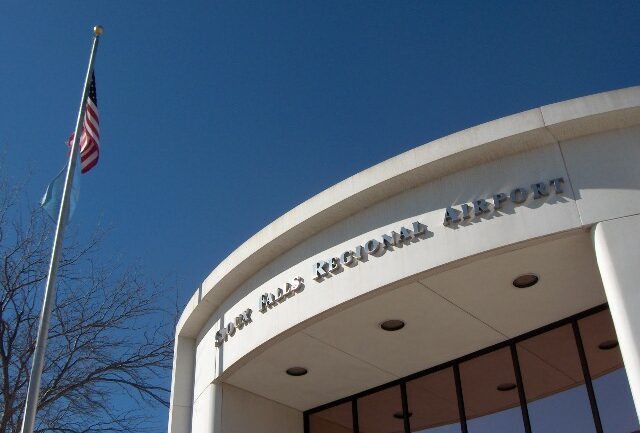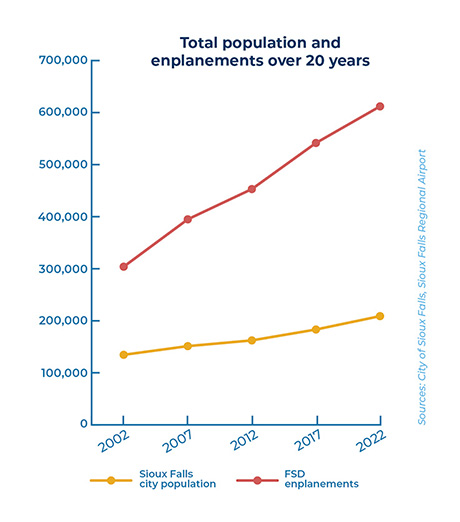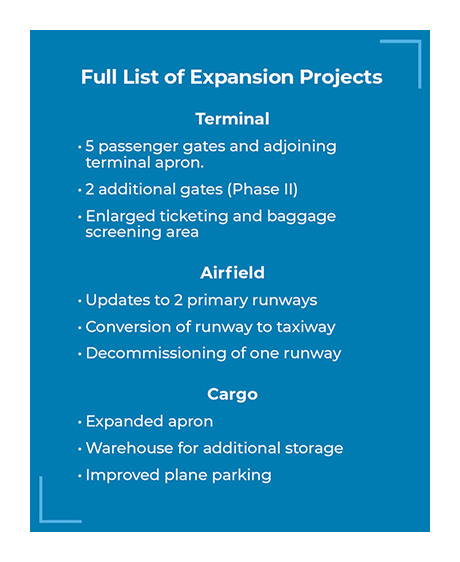
Airport poised for expansion
New master plan will fuel economic growth

It’s bold, but true: the Sioux Falls Regional Airport is a key driver of economic growth.
Long-time residents may be surprised by that, recalling when it was commonplace to drive to Omaha or Minneapolis in search of more economical fares and more accommodating flight schedules. But those days are long gone as Sioux Falls has steadily established itself as a growing hub vital to the area’s network of airports.
The airport’s rising profile – and Sioux Falls’ as a whole – is the result of intentional economic development efforts. Forward Sioux Falls, in particular, has long championed the benefits of Joe Foss Field through intentional marketing campaigns designed to increase passenger volume, reduce leakage to nearby hubs, and attract new carriers and services to FSD.
The effort has been effective.
“There’s an intricate web that keeps people and cargo moving across the US, and Sioux Falls fits right into it. Our airport is busy and getting busier,” said Dan Letellier, Executive Director of the Sioux Falls Regional Airport. “Our growth has tracked right alongside Sioux Falls’.”
Growing city, growing airport
It’s not news that Sioux Falls is growing; the city’s population has been on an upward trend since the 90s. Careful planning and capitalizing on economic opportunities have increased the area’s attractiveness, spurring even more growth. For each of the past three years, Sioux Falls’ growth has hovered around 3%.
While 3% doesn’t sound like much, in terms of people, it translated to more than 6,200 new residents in 2022. That number doesn’t simply mean more people and more housing. It also carries an increased need for infrastructure such as schools, roads, and libraries; more police, fire, EMS, and healthcare access; and more amenities such as restaurants, hotels, shopping, and of course, air travel.
Like the city of Sioux Falls, the airport is also experiencing steady and record-breaking growth. In 2022, more than 611,000 travelers – the largest number yet and double what it was ten years ago – relied on the Sioux Falls Regional Airport to vacation, see their families, explore new places, and meet their business obligations. As a growing destination for high-level sports competition, Sioux Falls’ airport is also making it easier for out-of-town teams and their fans to access the city for tournaments at the Sanford Sports Complex. If current projections hold, the airport will surpass two million annual passengers within fifteen years.
And that doesn’t account for the cargo sent in and out of SFRA. Sixty-nine million pounds of goods were unloaded at the airport in 2021, and while that number took a dip in 2022, it’s expected to rebound and continue to increase in 2023 and beyond.
“According to a 2020 economic impact study by the State of South Dakota, the airport annually brings a $400 million benefit to the Sioux Falls area,” stated Letellier. “That’s a huge contribution to the community, and for the airport to continue to provide that, it needs to meet the demand that comes with the area’s growth.”

Capitalizing on the growth
Anticipating and responding to the area’s steady growth is a long-standing habit for the airport. Letellier and members of the Sioux Falls Regional Airport Authority board rely heavily on data to guide every improvement project they undertake.
“We always strive to be good stewards of the dollars and space we have,” said Eric Ellefson, a licensed private pilot who’s in his fourth year on the airport authority board and is serving as the 2023 chair. “Our airport has had positive cash flow every year thanks to careful planning and an eye toward economic development.”
We always strive to be good stewards of the dollars and space we have. Our airport has had positive cash flow every year thanks to careful planning and an eye toward economic development.
One way the airport authority has made the most of its space and dollars is through a long-standing collaboration with its neighbor, the South Dakota Air National Guard. Since the air guard already employs a fire rescue team required by federal regulations, the airport can use theirs in exchange for lending the air guard use of their airstrips. “There is a $1 fee for the use of our airstrips, but that’s a pretty good exchange for not having to hire our own fire fighters,” said Ellefson, a partner at Click Rain, Inc. who is also a 23-year veteran of the SDANG.
As the airport’s current master plan neared expiration last year, the board re-engaged Mead & Hunt, a consulting firm that specializes in federal transportation, to create a new comprehensive plan to forecast the airport’s facility needs for the next ten years. The projects identified by the new plan fall into two main categories: passengers and cargo.
For passengers, the airport aims to address the increased passenger demand with an initial addition of five gates, adding two more in a second phase later on. That accomplishes the obvious task of accommodating more travelers and providing them with a wider selection of flight times, but it also has the added benefit of adding more overnight parking for airplanes.
“When you’re a smaller hub, you end up taking the early morning and late night flights that feed into the larger airports. With a nationwide pilot shortage, we can’t say no to those flights. But, flying in at the end of the day means we need to have a place for that plane to park overnight. Right now, our overnight plane parking is always full,” said Letellier.
“We already work with UPS and FedEx, but we hope to eventually attract Amazon, especially now that there’s a distribution center nearby,” said Letellier. “We’re also trying to make it possible for additional widebody cargo flights in the years ahead.”
Because of the interconnectedness of the airport’s operations and facilities, it’s difficult to isolate projects. Some of those slated for development in the master plan may appear ancillary, but Letellier and Ellefson assure people all the time that what’s in the plan is the result of careful consideration and planning, not a wishlist. And there are, of course, federal safety regulations to consider.
“When you begin adding gates or cargo space, you automatically have to review your runways and taxiways to ensure they can meet those changes. More passengers means more space is needed for parking, ticketing and baggage handling, more seating, and more food and beverage options. Likewise, our control tower also needs to be updated,” explained Letellier.
Because securing funding will take time, the expansion will likely happen in phases.
The timeline is fluid as it will depend on how soon funding comes in. The airport authority is already working with a design team so that estimates can be finalized so they can begin seeking funding. Some pandemic-era government programs they’re eligible for are set to expire within the next two years. The tentative plan is to begin construction in 2026.
“There’s some urgency to get this project moving forward. Costs keep rising, programs will expire, and the demand keeps growing,” said Ellefson. “The time is definitely now.”

Financing airport growth
Despite the pressing need for expansion, financing such a significant project poses a challenge. The Sioux Falls Regional Airport Authority, as an independent entity, must secure the necessary funding to undertake the estimated $130 million expansion plan. While the city, state, and federal government may be potential sources of financial support, none are obligated to provide funding.
“It’s a myth that the City of Sioux Falls or the government pays for the airport. There are certainly programs available to assist us, but the FAA focuses on safety and very basic infrastructure so when it comes to capital investments, we’re largely on our own to piece together the funding puzzle,” Ellefson said.
“We’re the only airport in the nation that’s never taken on long-term debt to finance its projects,” said Letellier, who is leading the multi-level parking ramp project that’s already underway at the airport. That project is its largest to date, coming in at $63 million. “To this point, we’ve been completely self-sustaining, and if we could manage this expansion on our own, we certainly would, but this time, we’re going to need help meeting the need.”
Letellier has found himself breaking new ground as he begins piecing together funding sources. State and federal funding is not only provided at the most basic level, one usually depends on the other. For example, if the Sioux Falls Regional Airport receives federal funding, the State of South Dakota will match it at a rate of 5%. Some contributions are capped – the state has a $250,000 limit on concourse development – and some, because the state has never had to address this level of growth before, are vague.

So vague, in fact, that Letellier is participating in a working group with South Dakota’s Department of Transportation to determine the best way to meet the increased financial demands of airports across the state. Rapid City is experiencing a similar climb as leaders also explore an airport expansion.
“For the last 20 years, the federal government has allocated an average of $3.35 billion dollars for airport construction projects across the nation. We are entitled to an annual allocation, but as a small hub airport, that funding source has not kept up with the skyrocketing costs of construction, especially as we experience this level of growth,” Letellier said. “We’ve been very diligent about working within the support we have, but if we are to complete these major capital projects, we’ll need assistance from all levels of government.”
SFRA’s reputation as a well-run enterprise has also garnered it long-standing support beyond government entities, particularly from Forward Sioux Falls (FSF). The two organizations have a reciprocal relationship – the airport board financially supports FSF’s program while FSF provides marketing opportunities and, when possible, helps meet the requirements for FSD airlines to expand their offerings as there is often a need to demonstrate community support before approval is granted by the carrier’s corporate office.
“We support our regional airport because a vibrant economy is extremely limited—if not impossible—without efficient, effective air service for both business and recreational travel,” said Mike Lynch, executive director of Forward Sioux Falls. “It’s prudent and essential for the Sioux Falls Regional Airport Authority to proactively embrace this opportunity by continuing to be in lockstep with this growth. The influx of new businesses in our community, along with the expansion of existing businesses, make the airport’s expansion effort even more crucial to meet increasing travel needs in our area.”
What if we don’t?
It’s certainly an option for the airport to pause its expansion plans. However, as Sioux Falls’ population continues to climb, the laws of supply and demand will go into effect, holding the number of available flights flat and sending fares higher. If that happens, it’s likely that Sioux Falls area consumers will go back to using airports in Omaha and Minneapolis to take advantage of better prices and schedules.
“One of our primary goals is to see people using their hometown airport! We want them here, and it gives us a lot of enjoyment seeing them come,” said Letellier.
The $400 million economic benefit the airport brings to the Sioux Falls area will also be compromised as travelers seek other, more accessible destinations to vacation, shop, and do business. The $130 million price tag for this expansion compared to the $400 million benefit makes the bold, but true opener even clearer: the Sioux Falls Regional Airport drives the area’s economic growth.
“Think about how much higher that $400 million could go with an expanded airport. It’s exciting to consider the possibilities this project will open up for Sioux Falls and the surrounding area,” said Ellefson.


